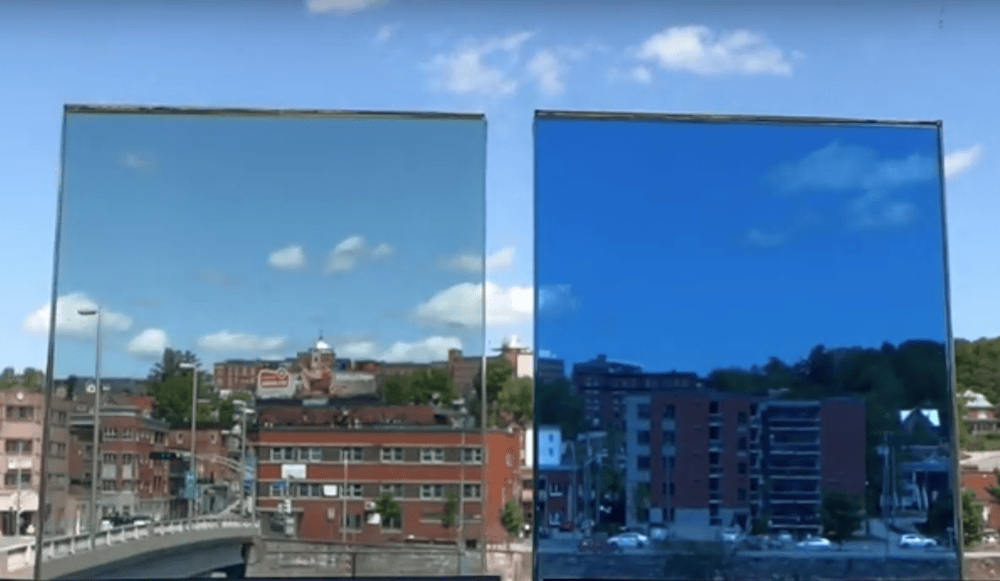
[Image above] An example of thermochromic glass, a type of passive smart glass technology that changes tint in response to heat. Researchers are actively investigating the use of vanadium dioxide in such glass. Credit: Vario Glass, YouTube
When people think of smart glass, they may imagine glass that switches immediately between transparent and translucent upon user command—such as the glass-walled restrooms highlighted recently in CTT. However, smart glass technologies come in both active and passive forms.
Active smart glass technologies, which offer immediate privacy, typically use electricity to change transparency. In contrast, passive smart glass technologies respond to nonelectrical stimuli such as light (photochromic) and heat (thermochromic), and thus serve well in applications that don’t require constant monitoring of transparency. For example, as coated eyeglasses that automatically tint in sunlight and coated windows that change in response to temperature.
The latter example—coated windows—is of particular interest recently because it offers a simple way to improve a building’s energy efficiency by reducing the heat load coming into the building. As such, a lot of research on thermochromic coatings took place over the past decade, and one material being investigated for this purpose is vanadium dioxide.
Vanadium dioxide is part of a unique group of materials that demonstrate a peculiar property called an insulator-metal transition. Once a certain temperature is reached, these materials switch from being insulating to conductive.
Compared to other materials with an insulator-metal transition, the transition in vanadium dioxide occurs closest to room temperature, at 340 K (67°C or 152°F). So harnessing vanadium dioxide’s transition in applications is much easier to achieve.
However, though the existence of an insulator-metal transition in vanadium dioxide was confirmed in 1959, the mechanism behind this transition remains hotly debated more than 60 years later.
There are several theories as to what causes the transition, as this 2018 review article explains, but one framework applied in recent years to understand the transition is overheating instability and the blow-up regime.
Overheating instability refers to conditions in which a system’s heat generation exceeds heat removal, causing sample temperature to increase over time. This instability can lead to the blow-up regime, which is when the rate of temperature increase is faster than exponential. (In formal terminology, the temperature becomes infinite in a finite time.)
These terms are generally used to explain observances in plasmas, semiconductors, and superconductors. But in the early 2010s, several papers starting from this one suggested the overheating mechanism also plays a role in the voltage-induced insulator-metal transition in vanadium dioxide. This suggestion was since developed in further studies, but one intriguing feature observed in numerous experiments remains unexplained—nonhomogeneous development of the overheating in homogeneous samples.
Explaining nonhomogeneous overheating in homogeneous samples
In a paper published this June, researchers from the Institute for Theoretical and Applied Electromagnetics at the Russian Academy of Sciences and the Moscow Institute of Physics and Technology looked to explain the nonhomogeneous overheating and how it relates to the insulator-metal transition within the framework of blow-up overheating instability.
At the beginning of their paper, they emphasize their goal is to provide a general explanation for the observances rather than construct a detailed theory of the phenomenon.
“The problem of the IMT [insulator-metal transition] in VO2 includes two aspects: microscopic and macroscopic. The microscopic aspect of the problem is a separate task, which is of interest and importance. … Here we consider only the macroscopic part of the problem. Thus, we do not discuss the physical nature of the IMT itself,” they write.
For their study, the researchers focused on investigating thin films of vanadium dioxide. Bulk samples of vanadium dioxide also exhibit the insulator-metal transition, but they tend to crack after several transition cycles because of changes in the crystal structure. In contrast, thin films are durable and can survive many transition cycles, thus making them more promising for applications.
The researchers first wanted to determine whether vanadium dioxide film structure affected occurrence of nonhomogeneous overheating. So they compared data on high-quality epitaxial vanadium dioxide films, which came from a 2013 paper, to data on nanocrystalline granular vanadium dioxide films, which came from experiments they performed.
They found qualitative observations of the insulator-metal transition in granular and epitaxial films were similar despite differences in the characteristic parameter values. “Thus, we conclude that a macroscopic mechanism of the IMT in the vanadium dioxide films is universal and independent of the film structure,” they write.
Following this conclusion, the researchers created models to study more closely the occurrence of nonhomogeneous overheating near the insulator-metal transition temperature.
They determined small local perturbations in the uniform temperature distribution leads to localized areas of overheating and blow-up, which thus raises temperature in that area high enough to cause the transition from insulating to conductive behavior. These localized blow-ups then grow and merge together, turning into a narrow, overheated conductive channel in the insulating environment.
The researchers note the mathematical description they proposed to explain this blow-up overheating mechanism is similar to that used to describe the superconductor-normal state transition in commercial high-Tc tapes. However, “the hot channel in high-Tc tapes is directed across the current flow in contrast to the IMT where instability develops along the current direction,” they write.
In an email, study co-author and MIPT doctoral student Viktor Polozov says they are now synthesizing vanadium dioxide films on various substrates, such as mono- and polycrystalline aluminum oxide, silicon, and silicon dioxide, to determine if structural and electronic properties of vanadium dioxide depend on the substrate material.
The paper, published in Physical Review B, is “Blow-up overheating instability in vanadium dioxide thin films” (DOI: 10.1103/PhysRevB.101.214310).
Author
Lisa McDonald
CTT Categories
- Basic Science
Related Posts
‘Fairy circles’ may help mark natural underground hydrogen deposits
September 18, 2025


